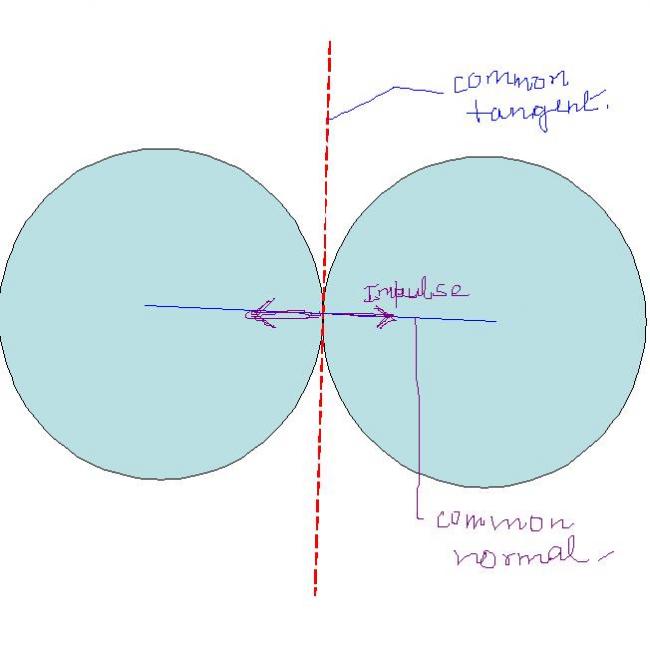i thought NORMAL force is always along the normal and if friction is not dere bodies exert only normal forces
!!
hope that explains it
i got four pts for objects in oblique collision in arihant i dont know how it came.please explain
of these three points are written below please explain
1)A pair of equal and opposite impulses act along common normal direction.Hence , linear momentum of individual particles do change along the common normal direction.If mass of colliding particles remain constant during collision,then we can say that linear velocity of the individual particles change during collision in this direction.
2)No component of impulse act along common tangent direction.Hence,linear momentum or linear velocity of the individual particles remain unchanged along this direction.
3)Net impulse on both the particle is zero during collision.Hence net momentum of both particles remain conserved before and after collision in any direction
i thought NORMAL force is always along the normal and if friction is not dere bodies exert only normal forces
!!
hope that explains it
any line on the plane of incl plane passing through the point of impact gives the tangent and perp to this line gives normal! [1]
frnd the explanation u had given is correct for two spheres collinding
but if u consider a ball is dropped on an inclined plane then how to identify??
if one single straight line can be drawn such that it touches two non-linear(2-D) shapes only at one point(ideally) then it is common tangent and if we can draw a line perpendicular to this common tangent such that it cuts the shapes at the points where the tangent had met them gives the common normal!! :)
☺♪♫░☺♪♫░☺♪♫░☺♪♫░☺♪♫░☺♪♫░☺♪♫░☺♪♫░☺♪♫░
the main point is that as on the system as no external impulse is acting... so the net momentum will be conserved... also the angular momentum of the system about any point will be conserved....
As far as 1st point is concerned...
"If mass of colliding particles remain constant during collision,then we can say that linear velocity of the individual particles change during collision in this direction."
Let impulse I acts on both particle...
then for one body I=Δ(mv)
If mass is not changing then mass can be taken out and then
I=m Δ(v)
So velocity changes...as I≠0
But if mass changes then... it can happen that mass changes but velocity remain constant... then I=v(Δm) which is still non zero...
I=Δ(mv)
[1]
☺♪♫░☺♪♫░☺♪♫░☺♪♫░☺♪♫░☺♪♫░☺♪♫░☺♪♫░☺♪♫░
oops abhi i know dat an equal and opposite impulse acts and i was confused y impulse shud act only on the along the common normal
oho [2]
isse badi dukh ki baat aur kya ho sakti hai [7]
i will write it 15 times [3]
Abhishek
Abhishek
Abhishek
Abhishek
Abhishek
Abhishek
Abhishek
Abhishek
Abhishek
Abhishek
Abhishek
Abhishek
Abhishek
Abhishek
Abhishek
[3] [copy-pasted]
3.) its almost explained in abhisekh's post no. 4.
.. since equal nn oppposite .. so net is zero ..
so since there is no net change in force in any dierction, so
momentum remains conserved .. [wrote the same sentence given [3] but i think u understood]
[why u should understood? [12] ]
2.) since impulse acts along common normal..
and common normal is perpendicular to common tangent
=> impulse has no component along common tangent.

Impulse =FΔt
By Newton's third law... equal and opposite force acts on both.... time of impact is also same.. so I is same and clearly opposite in direction..
abhi can u explain y shud an equal and opposite impulse shud act along the common normal of these two bodies